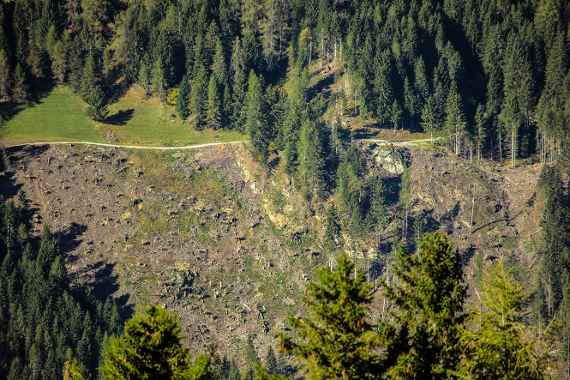Climate change and its effects in the protective forests
The scientific findings on the connection between greenhouse gases like CO2 and global climate change are meanwhile also known to the public and have been published for example in the reports of the Intergovernmental Panel on Climate Change. Due to the inertia of the climate system and the longevity of greenhouse gases temperatures will continue to rise until the end of the century even in the case of considerable emission savings.
The consequences of climate change are already visible in Austria. There are more hot days, a reduction of frosty days, the areas covered by glaciers have declined by 56 percent since 1850, vegetation periods are longer, new pathogens occur and extreme weather events and droughts are increasing.
Protective forests are subject to a large number of abiotic and biotic impacts and to continuous environmental change. According to scientific findings the climate of the future will be warmer and drier especially during the summer months. Extreme weather events like heat and dry periods will probably occur more frequently. In winter a larger portion of the precipitation will fall in the form of rain and the time of snow coverage will be shorter.
In the medium and long term these changes will have impacts on the structure of forests and on the tree species composition. Some coniferous trees, for example spruce and larch, will be more common in high-altitude areas in the future but will be replaced by more thermophilic species in lowlands. Therefore it is important to develop an area-wide, dynamic forest typification with information on the site, on water availability, soil and climate scenarios as is currently being done in a research project in Styria. The results are to provide a basis of planning and advisory services for forest management that is adapted to the relevant site and to the impacts of climate and are to help make forests climate-fit and future-proof.
Forest owners will have access to a recommendation of different suitable tree species that is specifically adapted to the location and takes into account the different climate scenarios.
The anthropogenic climate change will improve the protective effect at previously colder locations as forests can better thrive and may become denser under warmer conditions. However, in protective forests that are sensitive to dry conditions the mortality of trees may increase.
Climate change also alters natural hazard processes. Of course this also has an impact on the performance of the protective forest.
Major loss is expected to occur also in connection with large-scale disturbances in forests caused by fire, windthrow and bark beetle calamities. In October 2018, the storm “Vaia” tore large aisles into the protective forests of southern Austria. In Carinthia and Eastern Tyrol about 5,000 hectares of forest were affected.
It is also important to observe the adaptability and regenerative capacity in connection with change.
At dry locations especially the indigenous tree species of Scots pine and spruce are reaching their physiological limits as a consequence of the impacts of climate change.
Due to the long rotation periods of forest stands it is important to prepare for future climate conditions already now.

